
Lynxes living in the Carpathians use vast areas and often move across national borders, scientists from a Czech-Slovak-Polish team have found. They have been studying these animals for a decade using modern telemetry collars.
The Carpathians are among the most important European refuges for Eurasian lynxes. Experts from the Large Carnivore Initiative for Europe of the International Union for Conservation of Nature (IUCN) estimate that over 2,000 of these large wild cats live in the Carpathians. The mountains are intensively transformed by forest management, development of buildings and transport infrastructure, which affects the populations of large predatory mammals.
Scientists from Czechia, Slovakia and Poland investigated how Eurasian lynxes living in the Carpathians reacted to changes in the landscape caused by humans. The results of the study were published in the journal Scientific Reports.
Between 2011 and 2022, researchers caught 35 lynxes in special box traps equipped with alarm systems. They fitted the cats with GPS location collars. Every day, the collars sent scientists the coordinates of the places where the wild cats were staying. After completing their work, which usually lasted a dozen or so months, the collars' automatic magnetic locks would unfasten and they would fall off. Some of the collars were recovered and reused. The locations sent from the collars allowed the scientists to assess the areas used by the lynxes, and analyses using geographic information systems (GIS) indicated the factors influencing their use of areas.
The scientists found that male lynxes used much larger areas (an average of 283 km2) than females (an average of 148 km2). In addition, females raising kittens use much smaller areas (an average of 78 km2). After leaving their mothers' areas, young lynxes migrated over 12 to 90 km and settled in new places. They often crossed state borders during such migrations. According to the study co-author, Dr. Robert Mysłajek, a professor at the Faculty of Biology of the University of Warsaw and vice-president of the Association for Nature WOLF, lynxes in the Western Carpathians often cross the borders between Poland, Slovakia and Czechia, which shows that these countries should not only jointly monitor their populations, but also coordinate the protection of the species.
The results of analyses of factors influencing the size of lynx home ranges turned out to be interesting. The number of roe deer, the basis of these predators' diet, turned out to be crucial. The more roe deer there were in a given area, the smaller the lynx ranges were. In turn, with the increase in road density and the related fragmentation of the environment, the lynx home ranges increased.
Lynxes also showed great attachment to their habitats in the subsequent years of their lives. A small overlap of adult males' territories and significant distances between their centres of activity were also observed. The individual home ranges of males and females overlapped much more, and this tendency increased in winter, the lynx mating season.
The scientists say that the study results will help to create joint cross-border lynx protection programmes. This is important, for example, for the implementation of the objectives of the Carpathian Convention, to which Czechia, Slovakia and Poland are parties.
PAP - Science in Poland
zan/ agt/ kap/
tr. RL













